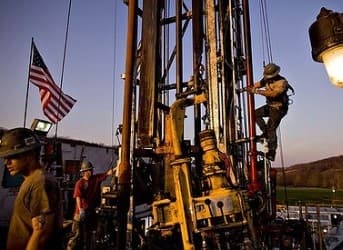The U.S. Energy Department said crude oil production from the United States could reach 7.5 million barrels per day before the end of the decade. Natural gas production, meanwhile, should increase to the point that the country becomes a net exporter of LNG. The report found most of the growth was from shale and other tight formations. Last month, shale opponents characterized U.S. growth predictions from the International Energy Agency as "dangerously false." Before the Energy Department's report, however, oil companies operating in some of the largest shale plays announced they were reserving a sizable portion of their 2013 budgets to capitalize on the U.S. oil and natural gas boom.
Last month, the International Energy Agency said it expected the United States would eclipse Saudi Arabia in terms of oil output within the next decade. The Paris-based agency said that, by 2025, the United States would pump about 10.9 million barrels of oil per day, 100,000 bpd more than Saudi Arabia.
Analysts, including those from Oilprice, questioned the IEA's reporting, however, describing the figures as "trick numbers." Others described the clamoring over the IEA's outlook as "political fodder," while advocacy group Food & Water Watch said the predictions were, for all intents and purposes, false.
The U.S. Energy Department, in its annual energy outlook for 2013, finds U.S. crude oil production should increase, on average, by 234,000 bpd through 2019. By then, the report states, U.S. crude oil production should reach 7.5 million bpd.
Related Article: How Shale Oil will Change the World
"The growth results largely from a significant increase in onshore crude oil production, particularly from shale and other tight formations," the report stated.
This week, Marathon Oil Corp. announced it was designating about one-third of its overall budget for next year to operations in the Eagle Ford shale play in southern Texas. There, the company said it expected to produce 85,000 net barrels of oil equivalent per day in 2013. Anadarko Petroleum, for its part, said four of its U.S. onshore assets, including Eagle Ford, were setting records for the company's performance.
The outlook is no less optimistic for natural gas. The Energy Department said higher volumes of shale natural gas production should keep exports going through 2020 as production outpaces demand. By 2027, the report said, the United States will be exporting liquefied natural gas to the tune of 1.6 trillion cubic feet.
In response to the IEA's reporting in November, Food & Water Watch said shale operations and other emerging developments, which it said were "extreme," would do little to support U.S. energy security in the long-term. For oil, at least, the detractors can find some assurance with the IEA's figures that state Saudi Arabia will return to the No.1 spot by 2030, outpacing the United States by more than 1 million bpd. The Energy Department, for its part, said domestic oil production should start to slow down after 2020 because developers by then will have tapped into all of the "sweet spots." For the short haul, however, there's enough of an incentive to convince company's like Marathon that the U.S. energy potential is worth spending around $1.9 billion per year.
ADVERTISEMENT
By. Daniel J. Graeber of Oilprice.com



















but a couple of things are apparent.
1. generation of electricity will move to gas instead of coal and although the thought of shipping to China is a good idea the Asian countries will soon get theidea that Global warming is a problem.
2 West Virginia was strongly against Obama but the price of coal will go down because it damages the environment,the users equipment ,and the people--it will become cheaper.
3. The reduction of coal usage will help keep price of Hydrocarbons stable.